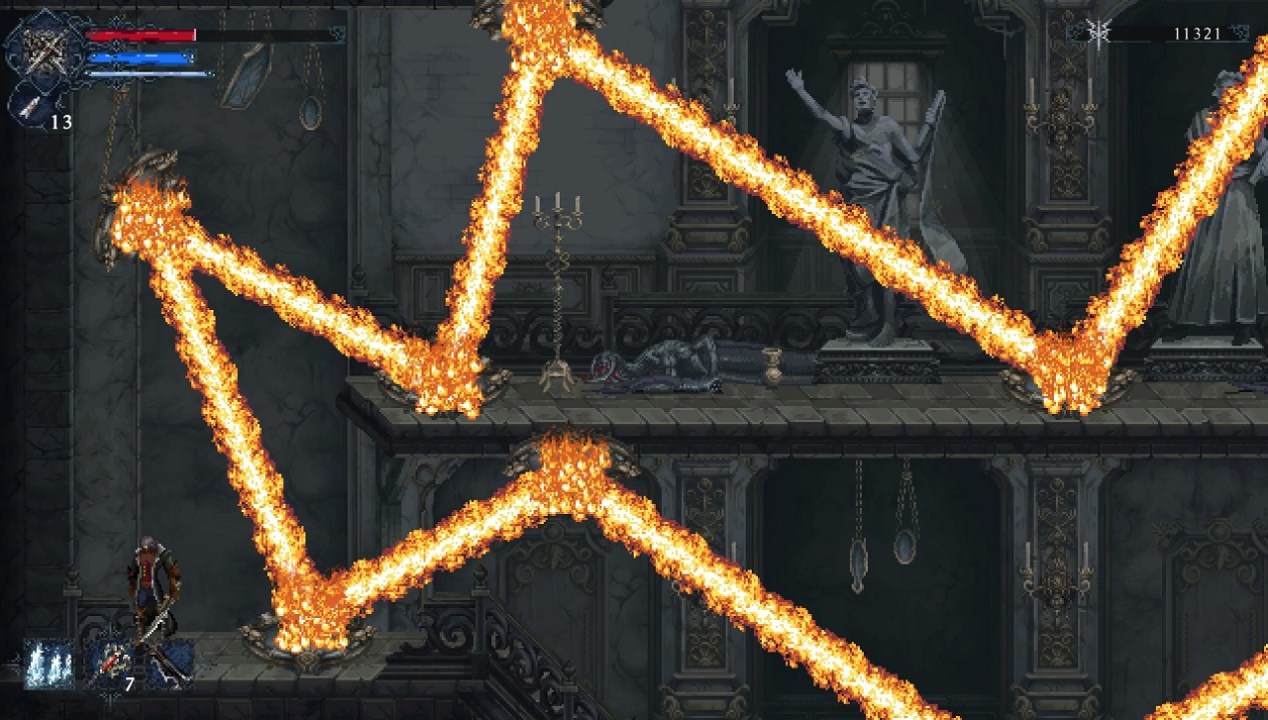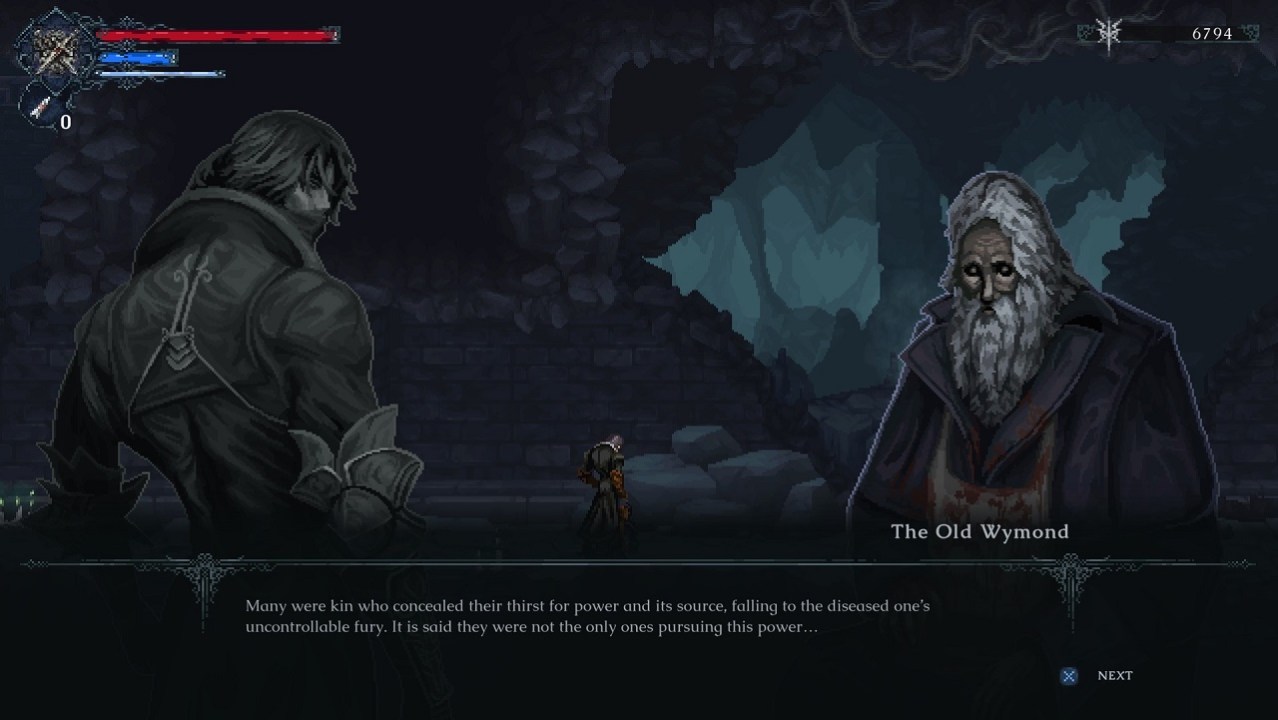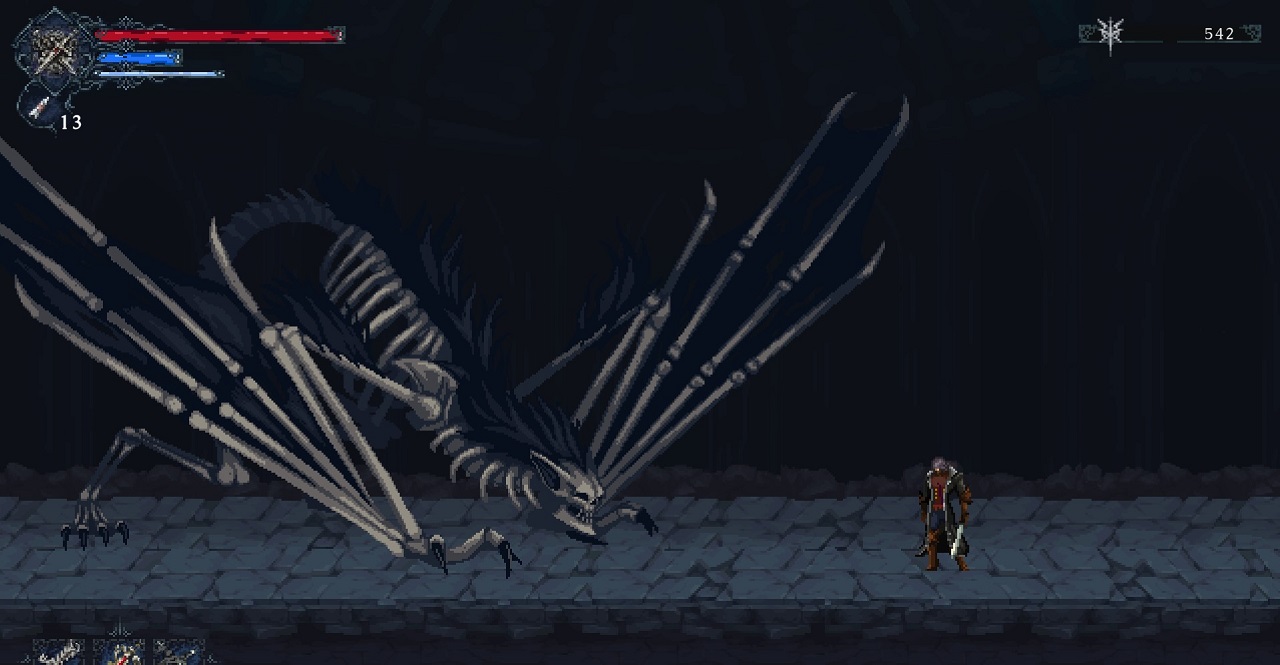As the old truism goes, imitation is the sincerest form of flattery. In the gaming industry, however, the finest line separates imitation from inspiration. Game developers who stray too far toward imitation will likely be accused of creating a soul-less ripoff of other games. But let inspiration run amok, and you risk losing the game’s tether to its genre and the good ideas that came before. The Last Faith, a Souls-like Metroidvania (one of the more crowded genres in the last few years) from Kumi Souls Games, sometimes walks deftly upon that line. At other times, it has both feet planted firmly on one side or the other, either imitating without innovation or trying to be so different that it leaves the game and player lacking direction and focus. Ideas from Bloodborne, Dead Cells, Salt and Sanctuary, and of course, Elden Ring can be found here, but ultimately, those games just do it better.
At times, The Last Faith adds up to more than the sum of its various inspirations, but the game’s quirks and curious design decisions make it hard to love the experience, no matter how hard you try.
What Does it All Mean?
The story starts simply enough: Your character, the brawler/stargazer/marksman/rogue Eryk, awakens with no memory, knowing only that something is eating away at him, threatening to erode that which makes him human. This same affliction has turned the inhabitants of the surrounding lands into the creatures you must fight along your journey. The game is full of NPCs who want you to help them or will offer you help, items for sale, information and more; pretty standard stuff, really. The problem lies with the overly convoluted language and methods used to convey that story, which makes gaining any real meaning from the narrative nigh-impossible. The game seems to delight in obfuscating the story, leaving cryptic notes around for the player to find while giving the NPCs lots to say that manages to not shed any light on what is actually going on.
Keeping track of what you know can be a treacherous task as well. The notes you pick up are at least available to re-read from the menu, but if you spend time grinding for “souls” with which to upgrade your stats or struggle with some of the truly difficult boss fights, it may be hours before you gain additional story bits, at which point you may no longer remember or care what happened before and what might be coming next. There are some genuinely attractive cut-scenes and the voice acting is top-notch, but all that means very little when the story is so incomprehensible. Notes and letters are found everywhere, offering flavor and details to the story, but in many cases they are locked away behind abilities you don’t gain until much later in the game, rendering them useless when you have experienced the rest of that particular narrative thread dozens of hours earlier. Just because you can emulate the FromSoftware method of storytelling doesn’t mean it’s the best thing for your game.

Take a Good Look Around
On the other hand, the game looks and sounds as good as anything on the market right now. Kumi Souls is to be widely commended for their attention to detail in both graphics and sound, as The Last Faith has one of the most fully realized, beautiful 2D-pixel art game worlds I’ve ever experienced. The amount of detail and creative touches never get old, and I found myself stopping to look at them even after nearly 75 hours of playing the game.
Hanging lamps sway in the breeze, grass waves lazily, and candles gutter as their flames die away, wax pooling all around. Multiple levels of foreground and background scroll by as you walk through each screen, giving the world a feeling of incredible depth and texture. Each biome is richly decorated, with icy stalagmites sticking out everywhere in the frozen zone, while gnarled and twisted trees devoid of life frame the swampland biome. Weather and environmental effects are just as well represented, with convincing rain and snowfall pelting down in various biomes. One of my favorite takes on this is an underground level where you take damage from the heat and fire in the air, visualized by glowing red sparks glinting menacingly in the darkness.
Character design is another feature to be appreciated, as the bestiary contains a wide range of creatures both normal and eldritch in nature. Humans abound, ready to do you in with rifles, cleavers, swords, and their bare hands. Spider-like creatures scuttle across the ground, spitting blood across the screen with deadly accuracy. Four-armed beasts with swords and pirate hats inhabit the seaside town, firing exploding harpoons that can end your run in a hurry. Early on, dilapidated mansions in the town of Mythringal are populated with corpulent ladies in French Maid outfits, intent on doing you in with cleavers and pools of bloody acid left in their wake. Moonlight pours through windows framed with shredded curtains as fog rolls through the outdoor screens, presenting an utterly convincing, once-prosperous world where few would now dare to tread. It is truly a feast for the eyes on every screen.

The game sounds just as good as it looks, and I’m guessing the development team spent a significant amount of their resources recording the audio or acquiring some excellent assets to use throughout the game. The background music is appropriately moody and subdued and never seems to get old no matter how long you listen. Footsteps echo convincingly with the surface your character treads upon, be it the hollow clunk of iron ladders or the rasping scrape of dirt-hewn floors in a moldy castle. Weapon sounds are prominent and distinct, the pistol and shotgun immediately discernible from the other with bullets plunking into or ricocheting off the surfaces they hit. Swords cleave the air convincingly, each sound distinct from the various maces and scythes that fill Eryk’s arsenal by the later stages of the game.
Enemies get the same high-quality sonic treatment. Feral beasts scream in the distance, the guttural growl of what used to be dogs announces their presence before you see them, and the human enemies utter terrifying threats from off-screen. Voice acting is another treat here, each performance believable and interesting, drawing you into the narrative even if it is hard to keep up with or care about the story itself. This is another credit to the developer for putting their money in the right places to craft a world you want to explore.
Don’t Let it Consume You
The gameplay is largely well done, starting with the animation and feeling of control you get when controlling your Eryk-avatar. Beginning the game as one of four classes that determines your starting stats, you’ll be shooting guns, casting spells, or getting up close and personal with a range of swords and axes. They all feel wonderful to wield, and delivering death blows feels meaty and impactful. You have a jump, dodge roll, and back-jump (later supplemented with a dash, grappling hook, and double jump) which are also beautifully animated and impart invincibility frames as appropriate to the genre. Getting the timing down for all the various moves and attacks is vital because combat can be incredibly tough, yet rewarding for those who master it. Killing enemies nets you currency with which to upgrade your various stats and weapons, and like with Elden Ring, you can purchase several levels of “+1” upgrades for your weapons, after finding or buying one of a few specialized ores from around the game world.
The moment-to-moment action lives up to the Souls-like billing because any monster can be a run-ender if you’re caught napping. Getting surrounded by a group is almost always deadly, so separating one or two from the crowd is essential whenever it can be managed. Every enemy, from the lowest human all the way to the biggest bosses, operates with tried and true patterns that can be observed relatively quickly. Taking advantage of them while triggering your various skills, applying health and mana recharges, and switching between weapons, however, is the true skill check. One way the developer aimed to set the game apart from its genre brethren is with an execution feature built into the combat, where pressing the appropriate button over a near-dead enemy results in a brutal and gory finishing move. It’s quite enjoyable the first few times you do it on each enemy type, but it quickly gets old and isn’t something you’ll bother with after a while.
The bosses, again in true Souls-like fashion, are huge screen-filling abominations, all bones and fangs and claws swiping at you time and again, taking off huge chunks of your life bar when you don’t get out of the way in time. The usual calculus of which weapon and spell to use for each encounter applies here, but because you can theoretically take on the biomes in almost any order, you may run into a boss you aren’t prepared to defeat at any given time. That will lead to a good bit of grinding for more souls to get stronger, faster, smarter, or whatever your character build calls for.

Puzzling Design Choices
This gets us to where things started to go off the rails, as the game design doesn’t hold up to the rest of the package that Kumi Souls has on offer. Sure, there are basic conventions of the Metroidvania genre that must be adhered to, backtracking chief among them, but the game leaves you almost entirely without direction after finishing a biome or when you might find yourself stuck. This led me to spend chunks of time stumbling around blindly, wondering if certain ledges were truly accessible with better jump-timing, or if they needed the as-yet-unattained double jump.
When you die and lose your souls, the map gives no indication whatsoever of where they are, so if you didn’t note what room you were in when you died, you might have a very tough time finding them to reclaim what was yours. You can put down icons on the map to indicate points of interest or places to check out later, but good luck remembering what any of it means as there are only four generic icons with no way to label them. You’ll be stuck later remembering if the tiny sword badge was supposed to denote a vendor or a weapon locked away behind a door, so maybe keep a notepad handy when you’re playing.
Puzzle design was another pain point for me, despite a promising start. To keep things away from spoiler territory, the first puzzle involved a note where the solution was shown through words in bold text on a note, prompting actions to be done in a certain order. The next big puzzle, however, was so obscure and out of pattern with the level in which it existed that I have no idea how anyone might find the solution on their own. It caused me an incredible amount of wasted time and frustration, and I fear it could cause some players to bounce off the game entirely.
Difficulty spikes in combat are a bit of a problem too, as you can easily find yourself in a “challenge room” that functions as a sort of mini-boss. These rooms feature multiple waves of enemies, some familiar and some brand new, that are much tougher than what you encounter just a few feet away in the main part of the level. There’s no warning when these rooms are imminent, as they look like any other, and because they gate you in immediately, there’s no way to escape with your life and “souls” intact. If you aren’t leveled up enough to take on the challenge, you’ll be faced with no choice but to go grind somewhere else to get back enough souls for an upgrade, something that happens frequently throughout the game.

Kumi Souls made some good design decisions, however, particularly when it comes to save points. Sprinkled throughout the land are altars (this game’s version of Elden Ring’s Lost Graces) where you can save your progress and replenish your consumable items like health and MP restoration. These also act as fast travel points, allowing you to jump to any other altar you’ve discovered across the map. In the beginning, the altars are plentiful but as the game goes along, there are much wider spaces between them.
The manor where you do your upgrading and leveling up of weapons is a nice touch, where certain characters you meet throughout the game will act as vendors. The developers also kindly included temporary save points outside most boss battles, so the amount of ground you must cover to get back into the fight after you die is typically quite minimal. And if you find yourself out of health kits following a death in a boss fight, the game conveniently gives you four of them right next to the spawn point so you have at least a chance when you dive back in. It’s a small touch, but it is appreciated when you’ve had twenty runs at a boss and you’re in dire straits.
Conclusion
For the sake of full transparency, I did not finish The Last Faith due to many of the frustrations I mentioned earlier, but having put almost 75 hours into the experience I’m quite confident in my ability to speak about the game’s high and low points. Fans of beautiful 2D pixel art will find a lot to love here, and I dare say the developer could find a welcoming audience for a companion digital art book, the quality is that high. It feels great to play, the combat is legitimately entertaining while still being very challenging, and everything just looks stunning when it’s in motion.
Unfortunately, I find I can’t recommend The Last Faith to anyone other than hardcore Souls-like Metroidvania fans due to the difficulty and frustration induced by the unfortunate design decisions that govern progression and combat difficulty spikes. If that doesn’t faze you then you definitely want to give this a look, but players who are new to the genre should look to another game for their jumping-in point.
You can find Seasoned Gaming’s review policy here





Man, maybe it was the fact that I erroneously took on the Frozen level after the first boss not knowing that, despite it being accessible with the very first ability you unlocked, it was not the progression tier. This enabled me to level up significantly before tackling the actual progression zones, but I found the game very easy aside from a couple of boss fights at the end. Especially once you get the ethereal great blade, all you have to do is put every stat point you have into strength and vitality and you will breeze through every enemy in the game.
Thanks for your comment, really glad to hear another perspective! Your experience was one of the things on my mind when I mentioned the lack of direction, as you can certainly stumble into a zone before you may have been “intended” to, and with no way of knowing that (as happened in your case), you could be OP from an early stage. I think I somewhat followed the progression the devs had in mind, but again, who knows?
I tried to find a balance in my review between what I loved about the game and the things that really put me off of it. The gameplay was really fun and my frustrations were eventually dealt with by grinding to upgrades stats & weapons, but feeling lost in a game isn’t necessary from a developer standpoint, there’s a way to find a happy medium between retaining a game’s mystery and overt handholding.
Good review. I finished the game 100% – although there is a bug with the achievement, annoyingly – and agree with most of your points.
The biggest letdown for me personally was by far the unnecessarily obtuse plot which led me to almost instantly disregard it and just enjoy the otherwise great combat and visual design.
Another frustration is that picking a starting class is largely irrelevant. You always get the same starter weapon, and a lot of the gear in-game is favoured towards the strength stat, so other approaches (besides one Dex weapon in particular) don’t seem very viable.
Genuinely curious on 2 points:
1. What puzzle is it that had you stumped?
2. How did you manage to sink 75(!) hours into this game? My final time clocked in at ~27 and a great deal of that was spent backtracking/trying to figure out where I was supposed to go!
[…] Ryan Cooper, an accomplished voice actor across indie games, audiobooks, and more. In our recent review of the indie Metroidvania The Last Faith, in which Ryan voiced The Old Wymond, among other characters, we specifically praised the quality […]